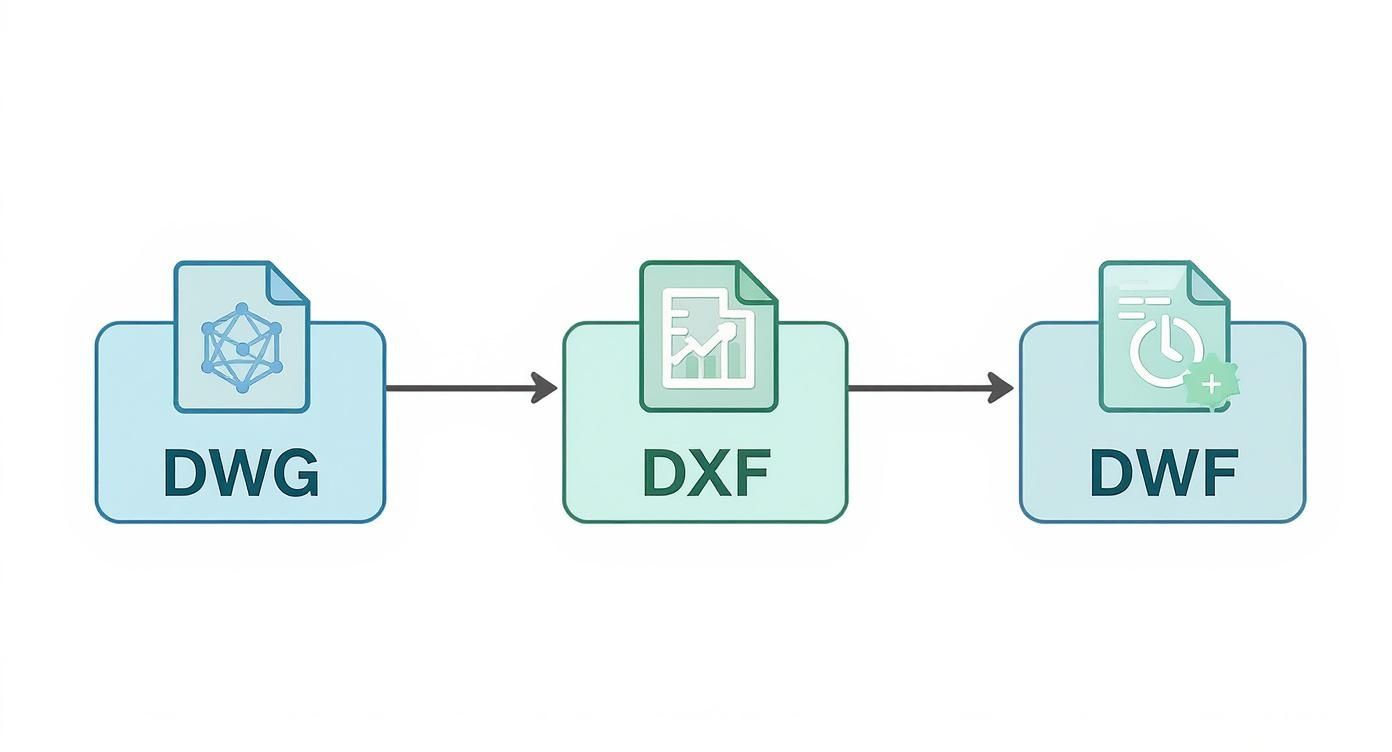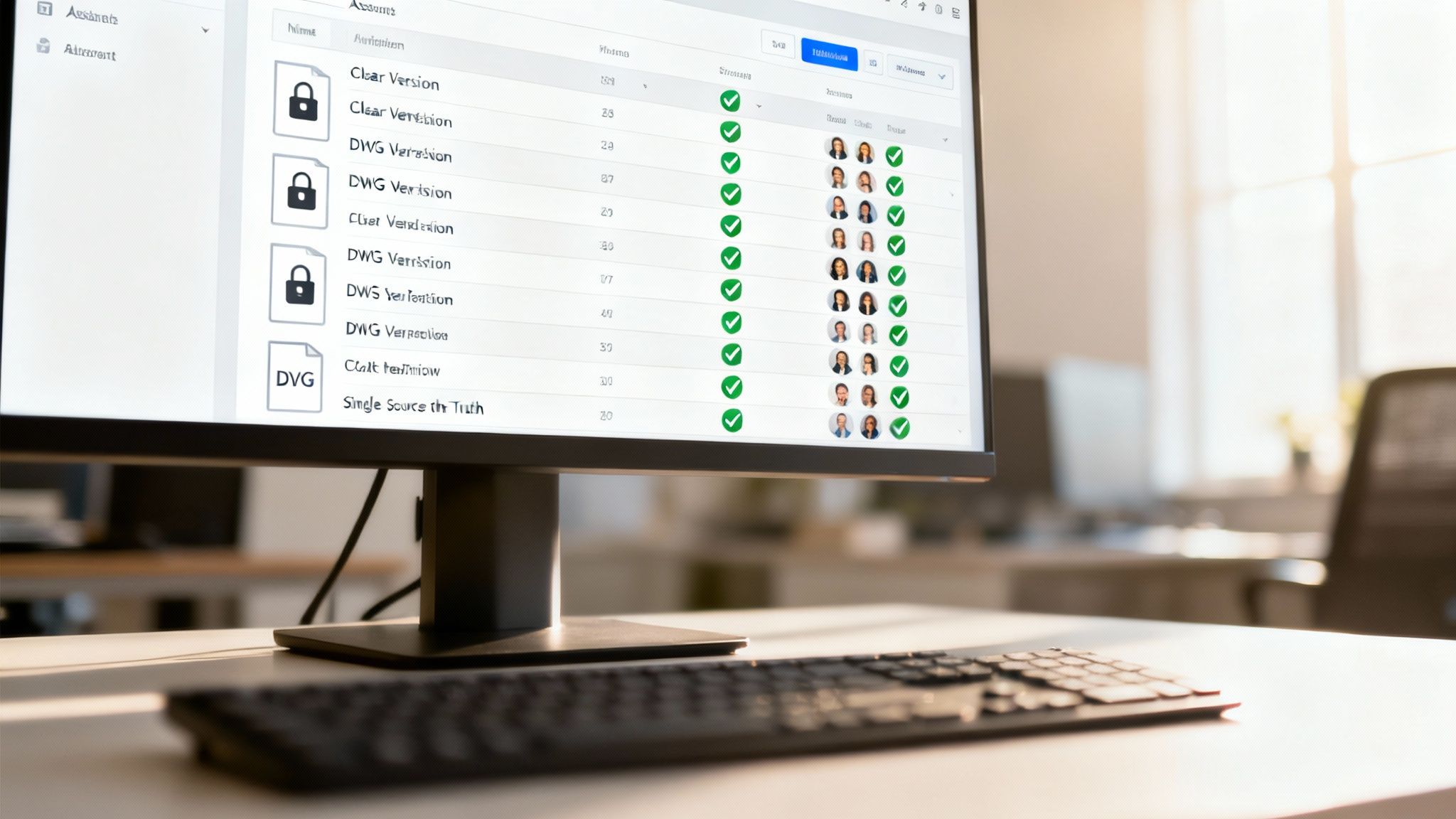For architects, engineers, and designers who manage complex visual projects, the DWG file format is the digital bedrock—the master blueprint. Keeping these mission-critical assets organized, secure, and accessible is a significant challenge. VirtuallPRO's Creative AI OS offers a responsible, compliant, and safe enterprise solution for creative and technical teams to handle these files with confidence. If you have not generated anything already, you can try it for free.
What Is a DWG File and Why Does It Matter?

Think of a DWG file as less of a file and more of a project's digital soul. The name itself is short for "drawing," and this proprietary format, first developed by Autodesk way back in 1982, has become the undisputed industry standard for 2D and 3D design data. It's the digital version of a meticulously detailed architectural drawing, holding every single critical detail in one place.
Unlike a simple image file like a JPEG, a DWG is a rich database packed with vector-based information. This means every line, arc, and 3D surface is defined by precise mathematical coordinates, not pixels. The result? You can scale it infinitely without losing a shred of quality—a non-negotiable requirement in professional design where accuracy is everything.
The Core Components of a DWG
At its heart, a DWG file is a container for complex design intelligence. Getting to grips with its structure is the key to understanding why it's so vital in professional settings.
A typical DWG file is built on these primary elements:
- Geometric Data: This is the visual foundation, containing all the vector information needed to render both 2D drafts and 3D models.
- Object Properties: Every single element, from a simple line to a complex 3D solid, carries its own properties like colour, layer, and line type.
- Metadata and Annotations: This includes all the text, dimensions, and other notes that give the design crucial context.
- External References (Xrefs): DWGs can link to other drawing files, which is a game-changer for collaboration. It allows teams to work on massive projects by referencing shared components without bloating the master file.
This structured approach guarantees that every aspect of a design is captured with precision. It’s this powerful combination of visual representation and deep underlying data that makes the DWG format so indispensable in technical fields. To see how DWGs function in the real world, check out these client cases in Engineering and Constructions.
A DWG file is more than just a picture; it's a comprehensive database of a project's design intent. It contains not only what a project looks like but also how it's constructed, layered, and dimensioned, serving as the single source of truth for technical teams.
The History and Evolution of DWG Files
To really get why the DWG format matters, you have to rewind to the early 1980s. Before computers took over, design was a physical grind. Think massive drafting tables, pencils, rulers, and a whole lot of erasing. Every single change meant redrawing by hand—a slow, painstaking process that put a real cap on speed and creativity.
Then, in 1982, Autodesk changed the game with the DWG format. The mission was huge but simple: move the entire drafting process from paper to the computer screen. This wasn't just about showing a picture; they needed a file that could hold a mountain of precise, editable data.
From Physical Blueprints to Digital Databases
The answer was a proprietary, binary format. By keeping it proprietary, Autodesk had full control, letting them tie it tightly to their flagship software, AutoCAD. The binary structure was all about efficiency—it packed complex geometric data into a small footprint, which was a lifesaver back when computer memory and storage were precious.
The DWG file quickly became the engine of the Computer-Aided Design (CAD) revolution. It wasn't just a static image; it was a database. Every line, arc, and circle was an object with its own properties—colour, layer, thickness—all stored as clean mathematical data. This was the leap from flat drawings to intelligent, dynamic models.
The impact was massive. The DWG format became the default standard for CAD drawings almost overnight, from engineering and architecture to construction. By 1998, Autodesk estimated there were already over two billion DWG files floating around the globe. That’s a staggering number that shows just how deeply it was adopted. You can get more context on its industry dominance in this insightful blog post about DWG files.
The Challenge of Constant Advancement
As technology got better, so did the DWG format. Autodesk rolled out new versions every few years, each one unlocking more complex and sophisticated design capabilities.
The evolution basically broke down like this:
- Early Days (Pre-2000s): The focus was on nailing down the core 2D drafting tools, layer management, and some basic 3D wireframe models.
- The 3D Push (2000-2010): This era brought huge leaps in 3D solid modelling, dynamic blocks, and better data linking. Designs were suddenly much smarter and more interactive.
- Modern Era (Post-2010): The format adapted again, adding support for cloud collaboration, advanced rendering, and tools built for how modern creative teams actually work.
Each new version of DWG opened up new creative doors. But it also created a headache that teams still deal with today: version compatibility. A file saved in a new version of AutoCAD often won't open in an older one without a conversion step.
This legacy of non-stop evolution is why the DWG format is both incredibly powerful and, at times, a real pain. Understanding its journey—from a simple fix for paper-based drafting to a complex digital standard—is the key to navigating the collaboration challenges that come with it. It explains exactly why managing different DWG versions is so critical for any team trying to keep their workflow smooth and efficient.
DWG vs. DXF vs. DWF: Choosing the Right Format
In the world of visual creative work, acronyms fly around fast. It’s easy to get lost.
When it comes to the DWG file format and its relatives, DXF and DWF, picking the right one is absolutely crucial for a smooth workflow. Get it wrong, and you could face lost data, collaboration nightmares, or even accidentally send an editable master file when all you wanted was a simple review.
Let's use a simple analogy from graphic design to make sense of it all.
Think of a DWG as your original, layered Photoshop (PSD) file. It's the master blueprint—fully editable, holding every single piece of data, and meant for the core creators. A DXF is like a universal vector file (think SVG), designed so almost any program can open it and understand the core geometry. And a DWF? That’s your high-quality PDF, perfect for sharing a non-editable "printout" for feedback.
The Original Blueprint: DWG
As we’ve covered, the DWG is the native, proprietary format for AutoCAD and many other CAD programs. It’s the source of truth for your design.
- Best for: Active design and editing within your team’s main software.
- Key Feature: Contains all the intelligent data—layers, 3D objects, metadata, and external references (Xrefs).
- Limitation: It’s proprietary, which can create compatibility headaches with non-Autodesk software or older versions.
You stick with DWG when you and your immediate team are deep in the design process. It’s the file you save, edit, and version control internally.
The Universal Translator: DXF
The DXF (Drawing Exchange Format) was Autodesk's answer to the closed-off nature of DWG. They created it as an open-source bridge to let different CAD programs talk to each other.
A DXF is essentially a plain-text version of the drawing data. This makes it incredibly versatile, as almost any design software can read its contents. But that translation isn't always perfect. While it reliably transfers core geometry like lines and arcs, it can sometimes lose more complex data like dynamic blocks or other proprietary features.
Use a DXF when you need to send an editable drawing to a collaborator who uses different CAD software. It’s the “universal key” that unlocks the basic design data for others.
The Secure Printout: DWF
Finally, there's the DWF (Design Web Format). This format was built for one main purpose: sharing designs for people to view, not edit.
A DWF is a compressed, lightweight, and secure file that’s incredibly easy to share. Think of it as a digital plot or a smart PDF specifically for design files.
Its main advantages are:
- Security: It protects your intellectual property. Recipients can’t easily modify the original design.
- File Size: DWFs are much smaller than DWGs, so they’re easy to email or share online.
- Markup Capability: Viewers can add comments, measurements, and notes directly onto the DWF without touching the source file.
You’d send a DWF to a client for approval, a contractor for a quote, or a project manager for review. It gives them all the visual information they need without handing over the keys to your master design.
This whole world of file formats can get complex, but understanding the basics is key. You can explore more about similar file types by checking out our guide on 3D file formats.
To make the choice even clearer, here’s a quick breakdown of how these three formats stack up against each other.
DWG vs DXF vs DWF At a Glance
Ultimately, choosing the right format comes down to your immediate task.
Are you editing, collaborating across different software, or just sharing for review? Answering that question will point you straight to DWG, DXF, or DWF—and keep your workflow efficient and secure.
How to Open, View, and Convert DWG Files
Getting into a DWG file without the right CAD software can feel like trying to pick a lock. But you don't always need the master key. Whether you're a designer making edits or a stakeholder just needing a quick look, there’s a whole range of tools out there to open, view, and even convert these files.
The most direct route, of course, is using native software like Autodesk AutoCAD. This gives you the keys to the kingdom—full editing power and guaranteed file fidelity. But for team members who just need to review a design, a full software licence is often overkill.
That’s where dedicated DWG viewers come in. Autodesk offers free tools like DWG TrueView and the web-based Autodesk Viewer, letting anyone open, measure, and print drawings without an AutoCAD subscription. Third-party apps like DraftSight also do a great job, often handling older, legacy file versions that other programs might struggle with.
Choosing Your Viewing and Conversion Tools
The right tool for the job really depends on what you’re trying to do with that DWG file. Are you just checking a few dimensions? Or do you need to pass the design to a collaborator who uses different software? Your answer points you to the right solution.
Think of the tools in three main camps:
- Native CAD Software (e.g., AutoCAD): This is the gold standard for creating and editing. It's for the core designers and engineers working directly on the master file.
- Desktop Viewers (e.g., DWG TrueView): Perfect for anyone who needs to view, measure, and print drawings accurately but doesn't need to make changes. These are secure, offline solutions.
- Online Viewers (e.g., Autodesk Viewer): Super convenient for a quick look without installing anything. You just upload the file and view it right in your browser.
Choosing between them is usually a trade-off between power, cost, and security.
The diagram below helps map out which format to use for which task—whether you're editing, sharing, or just reviewing.

As you can see, DWG is the source of truth for active design work, DXF is your best bet for interoperability, and DWF is the go-to for secure, view-only reviews.
The Risks and Rewards of Online Converters
Online conversion tools look incredibly tempting. Just upload your DWG, and get a PDF, DXF, or image file back in seconds. While they’re great for a quick, one-off task, they come with some serious security red flags.
When you upload a proprietary design to a random website, you’re handing over control of your intellectual property. For any serious creative team or business, this is a huge compliance and safety risk. It’s exactly why enterprises stick to secure platforms like VirtuallPRO, where sensitive design assets stay within a controlled, private environment.
Using an online converter means trusting an unknown third party with your confidential designs. For any project that matters, a secure, professional tool is always the smarter, safer choice.
If you absolutely must convert a file, keep these best practices in mind:
- Check Version Compatibility: Make sure the format you’re converting to can handle all the features in your original DWG. Downgrading a new DWG to an old format is a recipe for data loss.
- Verify Layers and Xrefs: Always do a spot-check after conversion. Have all your layers, external references (Xrefs), and annotations made the jump correctly?
- Use Trusted Software: Whenever possible, use a desktop app like DWG TrueView for conversions. It keeps the entire process on your own machine, offline and secure.
Knowing how to handle different file types is a core skill for any creative pro. For example, understanding how 3D models and their textures connect is just as crucial—something we cover in our guide on what an MTL file is. By picking the right tools and sticking to secure workflows, you can make sure everyone has the access they need without putting your project's integrity on the line.
Solving Common DWG Compatibility Issues
Few things kill creative momentum faster than a DWG file that just won’t open. The most common culprit? Version mismatch. Because the DWG file format has been evolving for decades, a file saved in a newer version of CAD software often throws a complete fit when you try to open it in an older program.
This is the classic roadblock for any team working with external partners. A file from AutoCAD 2018, for instance, has a different internal structure than one from 2013. The older software simply doesn't know how to read it. It's a frustrating but thankfully simple problem to fix once you know what's happening.
The easiest fix is to just ask the sender to save the file down to an older, more universal version. If that’s not an option, you can take matters into your own hands with a free tool like Autodesk’s DWG TrueView, which lets you convert the file yourself.
Diagnosing Deeper File Errors
But what if it's not a version issue? Sometimes you'll encounter a file that should open but instead gives you errors or looks completely wrong. This usually points to missing pieces or data corruption inside the file itself.
The two biggest offenders here are missing fonts and broken external references (Xrefs). The good news is that these issues don't mean the file is a lost cause. It just means your computer is missing the linked components needed to put the puzzle together correctly.
Here’s what to look out for:
- Missing Font Files (SHX): If a drawing was created with custom fonts that aren't installed on your machine, the software substitutes them with a default. This can completely wreck annotations and layouts, turning clean text into a jumbled mess. The fix is to get the original SHX font files and drop them into your CAD program's font folder.
- Broken External References (Xrefs): Think of Xrefs as linked DWG files layered into your main drawing—like a background, a floor plan, or a component. If those linked files get moved, renamed, or weren't included when the file was sent, the links break, leaving gaping holes in your design. You’ll need to either get the missing Xref files or relink them to their new location.
- Corrupted Data: After countless saves, edits, or a system crash, DWG files can sometimes accumulate errors. Most CAD software, including AutoCAD, comes with built-in first-aid tools. Commands like
RECOVERandAUDITare designed specifically to scan the file's database and fix internal errors.
When a DWG file misbehaves, it’s often an issue with its dependencies, not the core file. A quick check for missing fonts and broken Xrefs solves a surprising number of “unopenable” file headaches.
A Practical Troubleshooting Checklist
When a DWG file is giving you grief, don't just start clicking around. A methodical approach will save you time and prevent you from making things worse.
Here’s a simple checklist to run through:
- Check the Version: First things first. Make sure the file was saved in a version your software can actually read.
- Look for Missing Xrefs: Pop open the External References manager. Are all the links showing as "Loaded"? If not, you've found a problem.
- Resolve Font Issues: When the file opens, keep an eye on the command line for warnings about font substitutions.
- Run a Recovery Utility: If it won’t open at all, try using your software’s
RECOVERcommand. This is the go-to for suspected corruption. - Audit the File: Once it’s open, run the
AUDITcommand to scan for and fix any lingering internal errors. - Purge Unused Data: The
PURGEcommand is great for housekeeping. It removes junk data like unused layers and block definitions, which can sometimes resolve hidden conflicts and shrink your file size.
Following these steps will help you tackle the most common failures in the DWG file format, getting your projects back on track without the technical drama.
How to Tame Your DWG Files in a Creative Workflow

Knowing the tech behind the DWG file format is one thing. Actually wrangling hundreds of them across a creative team? That’s where things get messy.
The old way of doing things—emailing attachments, dumping files in generic cloud folders, or passing around USB sticks—is a recipe for chaos. It’s not long before the entire process descends into a frustrating mess. This is exactly why a proper creative workflow, built on a responsible platform, is so critical for visual creative work.
The pitfalls are all too common. Version confusion sends people off to work on outdated models, burning hours of time. Insecure file sharing puts your intellectual property at risk. And scattered feedback across emails and chat threads makes tracking approvals almost impossible.
Creating a Single Source of Truth
To break free from that cycle, your team needs a single source of truth—one central hub where every single design asset lives. A platform like the VirtuallPRO Creative AI OS provides this exact structure, turning a logistical headache into a real strategic advantage.
When everyone from the lead architect to the project manager is looking at the same file, the ambiguity disappears.
This centralised approach fixes the biggest problems right away:
- Version Control: Say goodbye to files named
Final_v2_final_REVISED.dwg. A real system tracks revisions automatically, so you can see a file’s entire history and roll back to an earlier version if something goes wrong. - Secure Access: You get to decide exactly who can view, edit, or download files. This is non-negotiable for protecting sensitive project data.
- Streamlined Reviews: All feedback and notes happen directly on the file, inside the platform. Communication stays in one place, creating a clear, actionable record of every decision.
A centralised system isn’t just for storage; it’s for control. It creates a secure, organised space that kills confusion and lets your team collaborate with confidence.
The Real-World Impact of Smart Asset Management
Moving to a structured approach for your DWGs has a direct and measurable impact. You slash the risk of costly errors caused by version mix-ups and tighten the security around your most valuable creative assets.
As digital collaboration becomes the default, this isn't just a "nice-to-have" anymore. In Denmark, for example, the CAD modelling software market is on track to hit US$4.89 billion by 2030, a surge driven by the demand for better data exchange. You can see the full breakdown in this in-depth market analysis.
Ultimately, managing your DWG files well is a core part of a healthy creative operation. By bringing them into a Creative OS, you’re building a workflow that’s resilient, secure, and ready to scale with your biggest projects. To go deeper, check out our guide on digital asset management best practices for more strategies on building a solid system for all your creative files.
DWG Files: Your Questions Answered
To wrap things up, let’s tackle some of the most common questions that pop up when working with DWG files. Think of this as the practical cheat sheet you need to handle these assets like a pro.
Can I Open a DWG File Without AutoCAD?
Yes, absolutely. You don’t need an expensive AutoCAD licence just to look at a DWG file. This is a huge relief for anyone who just needs to review, measure, or print a drawing.
Autodesk offers its own free tools like DWG TrueView (for your desktop) and the web-based Autodesk Viewer. Both are solid choices for accessing file contents without any editing features. Plenty of third-party programs also do the job, so you can easily stay in the loop on a project without needing the original design software.
What Is the Best Way to Share a DWG for Review?
This completely depends on what the other person needs to do. The golden rule? Never send your master DWG file unless the recipient absolutely has to make direct edits.
- For Viewing and Markup: Your best bet is to convert the file to a DWF (Design Web Format). It’s a secure, lightweight format that locks down your original design while still letting stakeholders add comments and take measurements.
- For Collaborating with Different Software: If your partner uses a different CAD program, send them a DXF (Drawing Exchange Format). It’s the universal translator for CAD, preserving all the core geometry so they can work on it in their own tool.
Why Won't My DWG File Open Correctly?
Nine times out of ten, it’s a version mismatch. A DWG file saved in a newer version of AutoCAD simply won't open in an older one. The fix is easy: just ask the sender to save the file down to a compatible older version.
A few other common culprits include:
- Missing Xrefs: The drawing is trying to pull in an external reference file that wasn't sent along with it, leaving a blank space where that content should be.
- Missing SHX Fonts: If the drawing uses custom fonts that aren't installed on your computer, the text will look like a jumbled mess.
- File Corruption: Sometimes, the file itself is damaged. Most CAD programs have a
RECOVERorAUDITcommand that can often repair the file.
When a DWG fails to open, it's usually a dependency issue, not a total disaster. Checking for version compatibility, missing fonts, and broken external links will solve the vast majority of problems and get you back on track.
Are Online DWG Viewers and Converters Safe to Use?
They’re convenient for a quick peek at something non-sensitive, but free online tools are a major security risk for any professional work. When you upload a proprietary design to a random website, you lose all control over your intellectual property. For any serious business, that's a huge compliance headache.
For professional teams, the only responsible way to handle sensitive design data is with secure, vetted desktop software or a controlled cloud environment like VirtuallPRO. This keeps your valuable assets locked down within your organisation’s own secure space.
Ready to bring order and security to your creative workflow? The Virtuall Creative AI OS is the single source of truth for all your design assets, including the complex DWG file format. Unify your generation, management, and collaboration in one secure workspace. Try VirtuallPRO for free and see how top creative teams build better, faster.











